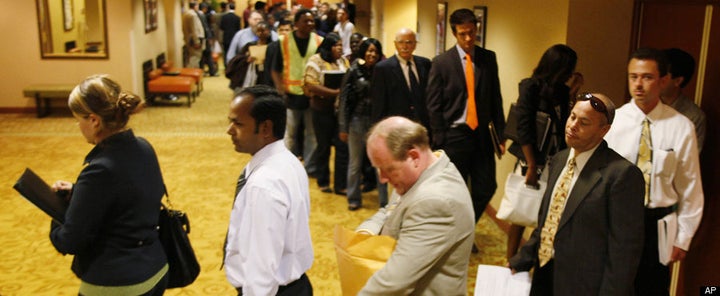
After a month of positive signs indicating a strengthening American economy, the news from Friday's Bureau of Labor statistics report paints a disappointing -- and confusing -- picture.
Although the unemployment rate fell to from 9.4 to 9 percent in January, a scant 36,000 jobs were added to payrolls. The word many economists are using Friday morning to describe this discrepancy is simply "confounding."
"We don't believe the extent of the drop in the unemployment rate," said Stuart Hoffman, an economist at PNC. "It's like funhouse mirror image, although I don't know if there's anything funny about it. The unemployment rate appears to be falling much stronger than it actually is, while payroll job growth is probably stronger than it actually is -- but certainly not strong enough to suggest that drop in the unemployment rate."
The Bureau of Labor Statistics' monthly report is composed from two different sources: the household employment survey, which is measured by contacting American workers, and payroll employment as reported by employers. The confusion surrounding this jobs report boils down to this: although there are now only 13.9 million officially unemployed Americans -- down from 14.5 last December -- that drop was not matched by an increase in hiring.
"It's like the unemployment rate is falling for all the wrong reasons," Hoffman said. "Who the hell can make sense of this report? It's distorted. It's definitely distorted."
One reason for January's sharp drop in unemployment is that more workers than ever have grown so discouraged that they have simply stopped looking for work. If an unemployed American stops searching for work, they are no longer counted as officially unemployed. Indeed, the pool of workers who have given up the hunt has reached a stunning new low for this recession: nearly 5 million have dropped out of the labor force completely.
Some of the lack of payroll jobs growth may be due to miserable January weather. "Given the confounding nature of this report, we will have to wait at least another month to see if the labor market is rebounding strongly," economist Heidi Shierholz writes, in a report today. She continues, zeroing in on a sharp fact:
Aside from today's muddled picture, one thing is crystal clear: the U.S. labor market started 2011 with half a million fewer jobs than it had eleven years ago, in January 2000, though the labor force has grown by nearly 11 million workers since then. Today's numbers are a testament to both the enormity of the current labor market crisis plus the very weak job growth of the 2000-2007 business cycle.
